Monster Radishes
“When one tugs at a single thing in nature, he finds it attached to the rest of the world.”
―
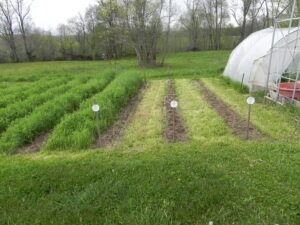 For the last several years we’ve been trying to improve our garden soil by growing cover crops. We started out using just winter ryegrass that we seeded in the fall. This type of rye grows slowly over the winter, and then as the weather warms in spring, it grows vigorously resulting in a nice mass of green material to be tilled in, as you can see in the picture. The last couple of years we found, at our local Amish garden store, a way to buy 50# bags of cover crop mix.
For the last several years we’ve been trying to improve our garden soil by growing cover crops. We started out using just winter ryegrass that we seeded in the fall. This type of rye grows slowly over the winter, and then as the weather warms in spring, it grows vigorously resulting in a nice mass of green material to be tilled in, as you can see in the picture. The last couple of years we found, at our local Amish garden store, a way to buy 50# bags of cover crop mix.
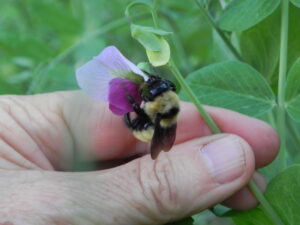 This mix includes field peas, the picture on the left, which the bumblebees loved.
This mix includes field peas, the picture on the left, which the bumblebees loved.
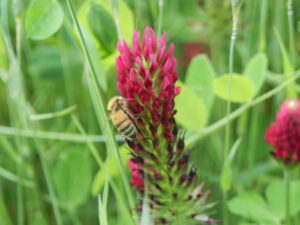
Crimson clover, which lots of bees and other pollinators liked. And, winter rye, and tillage radishes. The clover and peas fix nitrogen in the soil, which is great.
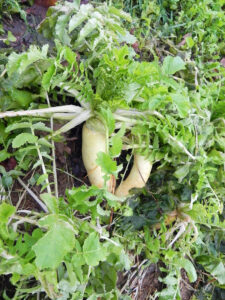
The rye adds organic matter and the radishes grow deep to help break up the hardpan.
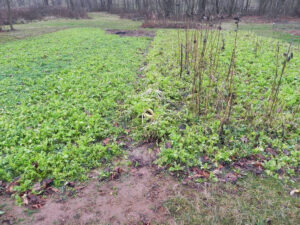 We found that planting this cover crop mid-summer rather than late summer, gave the tillage radishes time to get some good size. This past summer we used only half of one of our gardens for vegetables. The other half, which had field peas and crimson clover that overwintered, bloomed, and provided early summer forage for the pollinators, we replanted in cover crop mix, to allow it to grow all summer. The patch on the right. We also mixed sunflowers in with it when we seeded it and had some very nice late sunflowers, that the bees and birds enjoyed. That is, what the deer didn’t eat the tops off of. That’s the brown stalks you see.
We found that planting this cover crop mid-summer rather than late summer, gave the tillage radishes time to get some good size. This past summer we used only half of one of our gardens for vegetables. The other half, which had field peas and crimson clover that overwintered, bloomed, and provided early summer forage for the pollinators, we replanted in cover crop mix, to allow it to grow all summer. The patch on the right. We also mixed sunflowers in with it when we seeded it and had some very nice late sunflowers, that the bees and birds enjoyed. That is, what the deer didn’t eat the tops off of. That’s the brown stalks you see.
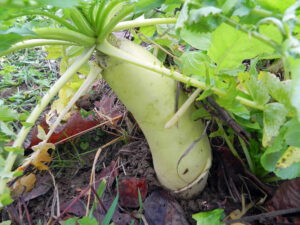 We were rewarded with some monster radishes. The radish pictured, above ground, is as big as my foot. While it seems to me, it would be better if the entire radish were below ground and growing into the clay soil, this is what is supposed to happen according to the promoters of these radishes; “Sown in late summer, it forms giant roots that are then winter-killed, which turns the roots into mush as the soil thaws. After a few weeks, the root mush starts to dry up, leaving behind air channels that help establish deeper tilth and dramatically increases the surface area of the soil that is exposed to air, allowing the soil to dry out more quickly—especially helpful in wet springs.” That’s info I pulled from an online source on these radishes. So, we’re eager to see if our giant, mushy, radishes do indeed, improve our garden soil! Have you ever smelled a radish gone to mush? As you can see in the picture above, we have a rather large patch of them. We may regret this experiment!
We were rewarded with some monster radishes. The radish pictured, above ground, is as big as my foot. While it seems to me, it would be better if the entire radish were below ground and growing into the clay soil, this is what is supposed to happen according to the promoters of these radishes; “Sown in late summer, it forms giant roots that are then winter-killed, which turns the roots into mush as the soil thaws. After a few weeks, the root mush starts to dry up, leaving behind air channels that help establish deeper tilth and dramatically increases the surface area of the soil that is exposed to air, allowing the soil to dry out more quickly—especially helpful in wet springs.” That’s info I pulled from an online source on these radishes. So, we’re eager to see if our giant, mushy, radishes do indeed, improve our garden soil! Have you ever smelled a radish gone to mush? As you can see in the picture above, we have a rather large patch of them. We may regret this experiment!
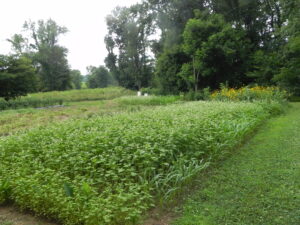 Once the weather warms in spring, we begin succession planting patches of buckwheat (on the left) not only for our honey bees but for all the pollinators including the monarchs. Buckwheat does triple duty as pollinator forage, it helps to smother weeds (beneath the patch on the left is a wildflower mix planting) and adds organic matter to the soil. I think I could even add a fourth duty because when left to go to seed, many birds love to eat the seeds.
Once the weather warms in spring, we begin succession planting patches of buckwheat (on the left) not only for our honey bees but for all the pollinators including the monarchs. Buckwheat does triple duty as pollinator forage, it helps to smother weeds (beneath the patch on the left is a wildflower mix planting) and adds organic matter to the soil. I think I could even add a fourth duty because when left to go to seed, many birds love to eat the seeds. 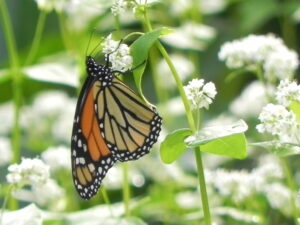
So, I’ve probably just told you far more than you ever wanted to know about cover crops, but hey, they’re good stuff!!
